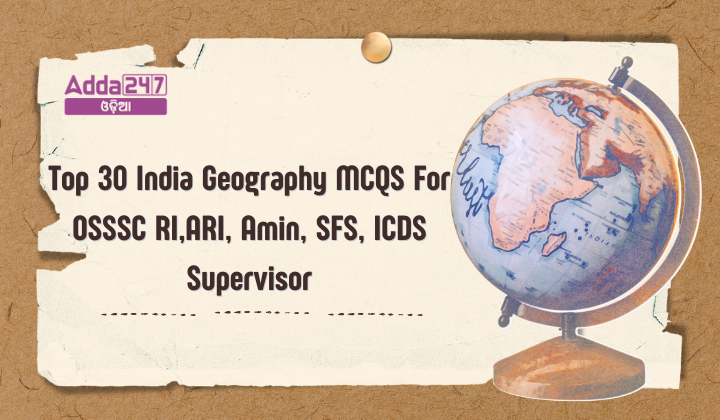Preparing for competitive exams such as OSSSC RI (Revenue Inspector), ARI (Assistant Revenue Inspector), Amin, SFS, or ICDS Supervisor often requires a strong grasp of historical events. Modern history, especially, forms a significant part of the syllabus, covering crucial periods and events that shaped the world as we know it today. To aid in your preparation, here are 30 multiple-choice questions (MCQs) focusing on modern history:
Top 30 Geography MCQS For OSSSC RI,ARI, Amin, SFS, ICDS Supervisor
- What is the rank of carbon in terms of abundance in the universe?
(a) First
(b) Second
(c) Third
(d) Fourth
Ans. (d) Fourth - Which of the following is a primary process in the carbon cycle?
(a) Nitrogen fixation
(b) Photosynthesis
(c) Precipitation
(d) Erosion
Ans. (b) Photosynthesis - What do plants use to convert carbon dioxide into glucose?
(a) Water and Oxygen
(b) Sunlight and Oxygen
(c) Sunlight and Carbon dioxide
(d) Water and Carbon dioxide
Ans. (c) Sunlight and Carbon dioxide - What happens to carbon dioxide during the process of photosynthesis?
(a) It is released into the atmosphere
(b) It is converted into oxygen
(c) It is fixed into carbohydrates
(d) It is stored in the soil
Ans. (c) It is fixed into carbohydrates - Which of the following is a product of the carbon fixation process?
(a) Water
(b) Glucose
(c) Oxygen
(d) Nitrogen
Ans. (b) Glucose - What becomes of the carbon in plants when they die and are buried over millions of years?
(a) It turns into fossil fuels
(b) It evaporates into the atmosphere
(c) It becomes part of new plants
(d) It turns into oxygen
Ans. (a) It turns into fossil fuels - What role does carbon dioxide play in the Earth’s atmosphere?
(a) It acts as a greenhouse gas
(b) It decreases global temperatures
(c) It reflects sunlight away from the Earth
(d) It causes the ozone layer to deplete
Ans. (a) It acts as a greenhouse gas - What would happen to the Earth without carbon dioxide and other greenhouse gases?
(a) The Earth would overheat
(b) The Earth would be a frozen world
(c) The Earth would become a desert
(d) The Earth’s atmosphere would collapse
Ans. (b) The Earth would be a frozen world - Which of the following statements about the carbon cycle is true?
(a) Carbon stays in one place forever
(b) Carbon is only found in living organisms
(c) The carbon cycle involves the atmosphere, biosphere, hydrosphere, and geosphere
(d) Carbon dioxide is the only form of carbon in the cycle
Ans. (c) The carbon cycle involves the atmosphere, biosphere, hydrosphere, and geosphere - How is most of the carbon released into the atmosphere?
(a) Through volcanic eruptions
(b) Through plant respiration
(c) By burning fossil fuels
(d) By decomposition of organic matter
Ans. (c) By burning fossil fuels - Which of the following is the most significant cause of species extinction in tropical rainforests?
(a) Over-exploitation
(b) Alien species invasions
(c) Habitat loss and fragmentation
(d) Co-extinctions
Ans: (c) Habitat loss and fragmentation - What is a common consequence when large habitats are broken into smaller fragments?
(a) Increase in species population
(b) Population regressions of certain species
(c) Stabilization of migratory species
(d) Improved biodiversity
Ans: (b) Population regressions of certain species - The Amazon rainforest is being cleared mainly for which of the following purposes?
(a) Urbanization
(b) Timber extraction
(c) Agricultural purposes
(d) Industrial development
Ans: (c) Agricultural purposes - Over-exploitation by humans has led to the extinction of which of the following species?
(a) African Elephant
(b) Passenger Pigeon
(c) Bengal Tiger
(d) Nile Perch
Ans: (b) Passenger Pigeon - The introduction of the Nile perch into Lake Victoria led to the extinction of which type of species?
(a) Cichlid fish
(b) Amphibians
(c) Reptiles
(d) Insects
Ans: (a) Cichlid fish - Which of the following is an example of an alien species invasion in India?
(a) Indian Peafowl
(b) African catfish (Clarias gariepinus)
(c) Royal Bengal Tiger
(d) Asiatic Lion
Ans: (b) African catfish (Clarias gariepinus) - Co-extinctions occur primarily due to which of the following reasons?
(a) Pollution
(b) Climate change
(c) Extinction of host species
(d) Over-harvesting
Ans: (c) Extinction of host species - Which of the following human activities is a major driver of habitat loss?
(a) Technological advancements
(b) Conservation efforts
(c) Agricultural expansion
(d) Space exploration
Ans: (c) Agricultural expansion - The extinction of which of the following species is associated with over-exploitation in marine environments?
(a) Bengal Tiger
(b) Steller’s sea cow
(c) Indian Rhino
(d) Blue Whale
Ans: (b) Steller’s sea cow - Alien species invasions often result in:
(a) Improved local biodiversity
(b) Reduction of native species
(c) Creation of new ecosystems
(d) Prevention of habitat loss
Ans: (b) Reduction of native species - What is a mountain?
(a) A large mass of ice
(b) An elevated portion of the Earth’s crust
(c) A flat land area
(d) A deep valley
Ans: (b) An elevated portion of the Earth’s crust - Which of the following is an example of a fold mountain?
(a) Mt. Kilimanjaro
(b) The Deccan plateau
(c) The Himalayas
(d) The Rhine valley
Ans: (c) The Himalayas - Which type of mountain is formed due to volcanic activity?
(a) Fold Mountain
(b) Block Mountain
(c) Volcanic Mountain
(d) Plateau Mountain
Ans: (c) Volcanic Mountain - Which of the following is a feature of block mountains?
(a) High conical peaks
(b) Rugged relief
(c) Displacement of land vertically
(d) Flat-topped land
Ans: (c) Displacement of land vertically - The Tibetan Plateau is known as:
(a) The largest plateau in Africa
(b) The highest plateau in the world
(c) The oldest plateau in India
(d) The most fertile plain
Ans: (b) The highest plateau in the world - Which of the following is a key characteristic of plains?
(a) High elevation
(b) Steep sides
(c) Generally flat terrain
(d) Deep valleys
Ans: (c) Generally flat terrain - Which plateau is rich in gold and diamond mining?
(a) The Chhotanagpur plateau
(b) The East African plateau
(c) The Western plateau of Australia
(d) The African plateau
Ans: (d) The African plateau - Which of the following plains is formed by the Ganga and Brahmaputra rivers?
(a) The Tibetan plateau
(b) The Indo-Gangetic plains
(c) The East African plains
(d) The Australian plains
Ans: (b) The Indo-Gangetic plains - What makes plains highly suitable for human habitation?
(a) High elevation
(b) Rich mineral deposits
(c) Fertile land and ease of construction
(d) Rugged terrain
Ans: (c) Fertile land and ease of construction - Which mountain range is the oldest fold mountain system in the world?
(a) The Himalayas
(b) The Alps
(c) The Aravali range
(d) The Appalachian Mountains
Ans: (c) The Aravali range










